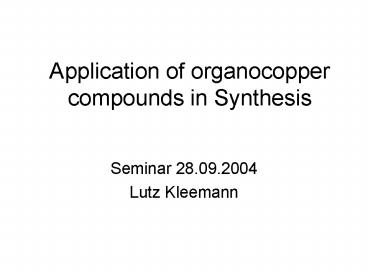Application of organocopper compounds in Synthesis - PowerPoint PPT Presentation
1 / 19
Title:
Application of organocopper compounds in Synthesis
Description:
In inorganic chemistry: mostly CuII-compounds (easy oxidation of CuI to CuII) ... Easy handling within low temperature and inert gas athmosphere ... – PowerPoint PPT presentation
Number of Views:2732
Avg rating:3.0/5.0
Title: Application of organocopper compounds in Synthesis
1
Application of organocopper compounds in
Synthesis
- Seminar 28.09.2004
- Lutz Kleemann
2
Toppics
- Formation, stability and reactivity of
organocopper reagents - Conjugate addition reaction
- Mechanism
- Examples
- Sn2 reaction
- General
- Others
3
Formation of Organocuprates
- Gilman-cuprates
- Dummy ligands (i.E. PhS-)
- atom efficiency
- Cyanocuprates (Lipshutz cuprates)
- higher order cuprates
- Copper catalysis
- structure mostly unknown, cristall-structures
show resting-state-species
4
Oxidation state
- Cu is group 11 element (silver, gold), oxidation
states 0-4 (Cu0-complexes only in matrix
isolation) - In inorganic chemistry mostly CuII-compounds
(easy oxidation of CuI to CuII) - but only one examply of CuII-organocuprate is
described (Ph-Cu-Ph, so far unreproducable!) - Organocuprates mostly CuI
- CuIII is important in intermediates
- CuIV is instable in organic chemistry
5
Stability and reactivity
- Thermal stability only up to 0C
- alkylltarylltltalkenylltalkynyl
- Increase of stability by
- substitution from H-Atoms with F
- ligands like phosphines, amines
- intramolekular coordiantion
- Organocuprates are highly aggregated species,
reactivity is influenced by solvens effects
6
Possible reactions of organo copper compounds
7
Conjugate Addition reactions
- Four-centred a) and six-centred b) mechanism
- Both do not explain E/Z-mixtures of the enolate
- Single electron transfer theorem, but
- E/Z-Isomerisation accours in presence of LiI.
- b-Cyclopropane ring opening once took as a
strong evidence for radical anion formation by
SET, indicates stereocontroll. - ESR and CINP studies failed to detect radicals.
- only CuIII-intermediate survived proof of time
8
Single electron-transfer Theorem
S. Mori, E. Nakamura in Modern Organocopper
Chemistry, Ed. N. Krause, Wiley-VCH 2002.
9
Application of quatenary carbon atoms
I. Hanna, P. Wlodyka, J. Org. Chem. 1997, 62,
6985.
10
Introduction auf sp2 carbon side chain via
conjugate addition of vinyl cuprate
Cuprate addition 91
J. Mulzer, D. Dürner, D. Trauner, Angew. Chem.
1996, 108, 2046.
11
Polypropionate synthesis highly stereocontrolled
conj. addition
S. Hanessian, K. Sami, Synthesis 1991, 1083. S.
Hanessian, W. Wang, Y. Gari, E. Olivier, J. Amer.
Chem. Soc. 1997, 119, 10034.
12
(No Transcript)
13
Introduction of multifunktional group in final
coupling step
Ideal solution to the problems of trisubstituted
olefin synthesis!
R. E. Ireland, J. L. Gleason, L. D. Gegnas, T. K.
Highsmith, J. Org. Chem. 1996, 61, 6856.
14
Transmetalation
S. C. Roy, L. Nagarajan, R. G. Salomon, J. Org.
Chem. 1999, 64, 1218.
15
One-pot three-component synthesis
Y. Yamamoto, N. Asao, T. Uyehara, J. Amer. Chem.
Soc. 1992, 114, 5427. C. Palomo, J. M. Aizpurua,
J. J. Garenea, S. García-Granda, P. Pertierra,
Eur. J. Org. Chem. 1998, 2201. M. Suzuki, Y.
Morita, H. Koyano, M. Koga, R. Noyori,
Tetrahedron 1990, 46, 4809.
16
Sn2 reaction
- Frequently used in organic synthesis
- Comparable to Suzuki and Stille coupling
- Efficient method for the synthesis of
3-substituted olefins
17
Substitution with copper organyle
Y.-Q, Mu, R. A. Gibbs, Tetrahedron 1995, 36, 5669.
18
Others
- 1,2-Metalate Rearrangment (Kocienski reaction)
- Carbocuration
- Cis addition to Alkynes
- Addition of heteroatoms like stannyl or
sily-groups
P. Koncienski, S. Wadman, K. Cooper, J. Amer.
Chem. Soc. 1989, 111, 2363. J. F. Normant, A.
Alexakis, Synthesis 1981, 841.
19
Conclusion
- Many applications of copper reagents in organic
synthesis - Easy handling within low temperature and inert
gas athmosphere - Biggest problem is to find the best copper
species - Organocurates still used as black box-reagents,
mechanism still isnt sure

